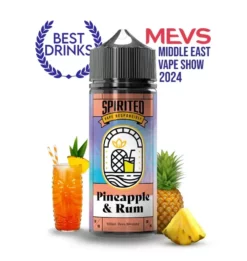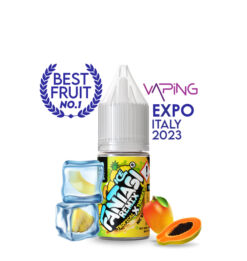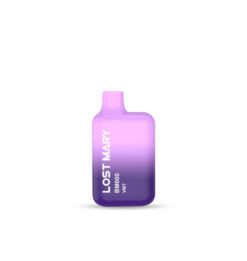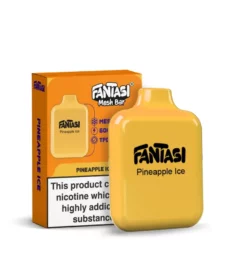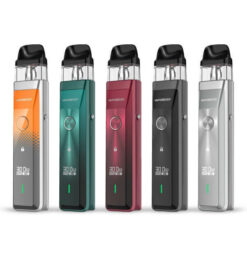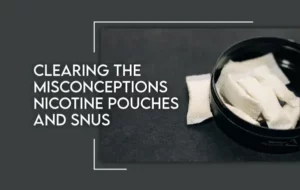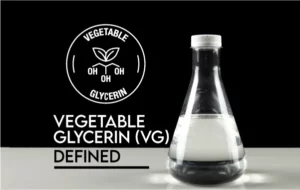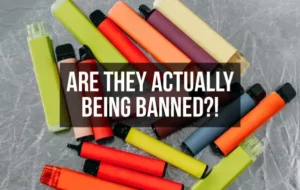TPD and TRPR
The TPD or Tobacco Products Directive is a directive created by the European Union in 2014 that introduced and outlined new regulations on e-cigarettes and tobacco products.
The Tobacco and Related Products Regulations (TRPR) is a set of documents introduced by the UK in 2016 implementing as well as expanding on the rules and regulations on e-cigs set by the TPD.
In this blog, we’ll take you through the relevant regulations in the TRPR documents, what they mean for the vapers of Britain and give you some guidance on how you can stay safe and compliant with your vape devices.

What Are The Main TPD UK Regulations On Vapes?
A range of new guidelines regarding the buying, selling and manufacturing of e-cigarettes and e-liquids were implemented in the 2016 documents, but these are the TPD uk regulations that are most relevant to consumers.
- E-liquid and vape devices must have child resistant and tamper proof packaging
- Vape devices must be resistant to leaks or breakage
- All vape products must have clear warning and safety information
- Disposable vapes must not exceed a capacity of 2ml nicotine containing e liquid
- All E-cigarettes and eliquids must be registered with the MHRA before sale is permitted
- E cig devices must deliver nicotine doses equally across each puff
- Electronic vape devices must be refillable without any leaking
- Caffeine, taurine and colourings are not permitted for use in any e-liquids
- Vape devices with pods, tanks or cartridges can not exceed a 2ml capacity
- Any eliquid containing nicotine can only be sold at a maximum volume of 10ml
- E liquids cannot contain nicotine strengths of more than 20mg/ml

How Do TRPR Regulations Affect Vapers?
The main regulations that had a more serious impact on consumers were changes to nicotine strengths and the sale of e-liquids containing nicotine. The new regulations meant that e-liquids containing nicotine could only be sold in 10ml bottles, a much smaller alternative to what many vapers and manufacturers were used to.
As a solution to the limitations set in place regarding nicotine, manufacturers introduced shortfill bottles. These bottles offer nicotine free e-liquid in volumes of around 50ml to 100ml depending on your choice of nicotine strength. Each bottle contains space for vapers to add their own 10ml nicotine shots to the shortfill bottle to make nicotine strengths of either 3mg or 6mg. With a shortfill bottle, you simply mix the nicotine free e-liquid with nicotine shots and you have a full bottle of liquid ready for vaping.
This regulation did pose a new opportunity for vapers as it allowed them to purchase nicotine free e-liquids as well as have a choice over the type of nicotine they add to their bottles. Consumers can now choose from freebase nicotine and nicotine salt options to add to their e-liquid shortfill bottles. It is now also possible to add products like cbd shots to e-liquid shortfill bottles too.
Whilst this new regulation initially appeared a setback to many manufacturers, it has in fact resulted in a more customisable and personalisable experience for the average vaper.
Another big regulation that affects vapers is the limit of 20mg/ml nicotine concentration or 2% nicotine in each vape juice, alongside the reduced tank, pod and cartridge and disposable vape capacity of 2ml. These rules were introduced to ensure the safety of consumers and to ensure vapers don’t intake an unhealthy level of nicotine. With these regulations in place, the maximum strength of nicotine you can purchase is 20mg in a 10ml bottle.
Other TPD uk regulations were certainly introduced to directly benefit the consumer. Rules like the requirement of consistent nicotine dosages across each puff ensure vapers experience safe and stable nicotine intact throughout their vaping experience.
Stricter laws on child proofing for vapes and vape liquids have also helped consumers feel safer buying vaping products with the reduced chance of children ingesting vape juices or swallowing small device parts.

How Can I Tell If A Vape Is Legal Or Illegal?
Despite the TPD UK regulations introducing strict guidelines on e-cig and vape juices, there are still many products on the market across Britain that violate these guidelines. If you want to ensure you’ve vaping a legal product and protecting your health, you can check the MHRA website to verify if a brand is regulated and approved by the TPD.
Check out our guidelines on various vape products down below.
Disposables
Any disposable vape that contains more than 2ml of nicotine e-liquid is an illegal product. Legal disposables are advertised as having 2ml or 600 puff equivalent inside. Many disposable vapes boast up to 3500 puffs and are noticeably larger in size, however if these contain nicotine, as they often do, they are an illegal product. Shops caught selling this type of vape can face very heavy fines and further legal action. If you’re buying vapes, always be cautious of physical brick and mortar shops and ensure you’re buying from a reputable retailer.
To ensure your safety, go by the 2ml or 600 puff guidelines, or opt for a pod device or vape kit so you can enjoy your vape for longer and safely.
E-Liquids
The legal nicotine strength for all vape liquids is 20mg/ml. The maximum size of a nicotine inclusive e-liquid is a 10ml bottle. This means if you see any e-liquids that advertise strengths of higher than 20mg or 2% they are illegal products.
Any e-liquid containing nicotine in a bottle of more than 10ml should also be avoided. Remember that if you want a bigger bottle, shortfill bottles combined with 10ml nic shots are the safe and compliant option.
Vape Devices
Vape devices with pods, tanks or cartridges can not exceed a 2ml capacity
Any vape you buy that contains a refillable tank, whether that be a pod style device or an advanced kit with built in tank, should not be able to contain more than 2ml of liquid. If you purchase a device that can hold more than 2ml of liquid this is an unregistered product and could cause potential harm to your health.
Counterfeit Vapes
As well as a range of unbranded products that fail to comply with TPD UK regulations there are a number of vapes on the market that are fake or counterfeit versions of popular brands. Investigations have found names like SKE, Lost Mary and Elf Bar are just a few of the companies being illegally copied.
To ensure you’re getting the real deal, opt for buying through sellers authorised by the MHRA or go to the brand directly for purchase. You can also scan QR codes on some branded packaging that will direct you to authenticity websites. If you’re still buying from local shops or convenience stores be sure to look out for all the above listed restrictions on nicotine strength and ml limitations as well as some additional information.
Ensure that every product you buy has clear nicotine health warnings on the packaging as well as a list of ingredients. Caffeine, diacetyl, taurine and colourings are all banned in UK vapes, with diacetyl posing potentially serious health risks.
There should also be clear hazard symbols and statements on how to use and dispose of the product, as well as an expiry date and a batch number. If any of this information is absent, avoid the vape altogether.

What Happens If I Use Illegal Vape Products?
When it comes to using illegal vapes or products not approved by the TRPR, the biggest risk is to your health. Products that are not regulated or products that have been banned within the EU can contain a number of harmful chemicals and substances including diacetyl, the substance that causes ‘popcorn lung’ or lung damage in individuals. Diacetyl is a banned substance in regulated UK vapes, so when you buy legal products you’re safe from any dangerous chemicals like this.
If you choose illegal vapes, you’re putting yourself at risk of developing a range of health problems we may not have studied or previously treated.
For those who sell and distribute illegal vapes, the consequences can be severe. Sellers who chose to sell unauthorised products can face closure, heavy fines and even prison time.
Ultimately, the rules and regulations set out in the TPD were devised to help protect the public from harmful products and ensure the regulation of safe vapes and e-cig liquids.

Are Vapes Becoming Illegal In The UK?
Vaping in general is very much still legal in the UK but there is much speculation regarding the possibility of disposable vapes being banned. The various concerns around disposables including environmental impact, unlicensed disposables and their appeal to children and teenages, have led to the government considering banning the devices.
As many other countries have already embarked on a mission to ban disposable vapes, it is believed that Britain could follow the same route in the near future.

Are There TPD UK Regulations On Vaping In Public?
At the current moment, there are no laws against vaping in public places and it is deemed legal to vape in public. There are guidelines put in place by PHE that allow organisations to make their own vaping policies and decide if vaping is allowed.
The biggest examples of this are seen on public transport. Various public transport providers like bus, train and tram companies have different rules on vaping and many ban the use of e-cigarettes on their services and have clear signage indicating no vaping rules.
Large chain restaurants, shops and department stores and pubs like Wetherspoons have also banned the use of vapes inside their premises. Just like smokers, vapers have to stand outside in a public area to use their vapes during meals or drinks.
If you are unsure if you are allowed to vape in an indoor area or on public transport and there are no clear signs, it is always best to ask a member of staff before vaping or refrain from vaping until outdoors.

Fully TPD Compliant Products at Vapoholic
Since the introduction of the TRPR regulations in 2016, the vaping scene has changed dramatically and the industry will continue to evolve. With much speculation surrounding new laws and rules for vapes in the UK, we’re uncertain what the future may hold for devices like disposable vapes.
One thing for certain is that it is highly unlikely we’ll see a full ban on vaping across Britain, as vapes themselves are an NHS approved stop smoking aid.
All of the vape juices sold and produced by Vapoholic are TPD compliant so you can rest assured that you are getting high quality, safe e-liquids that are upheld to manufacturing standards.

